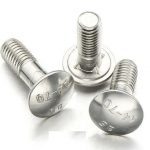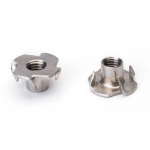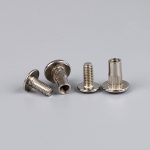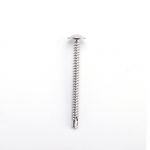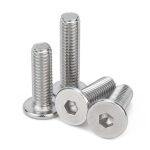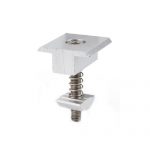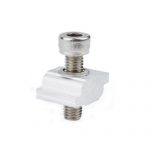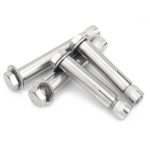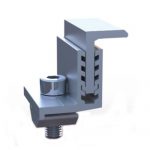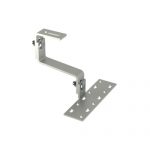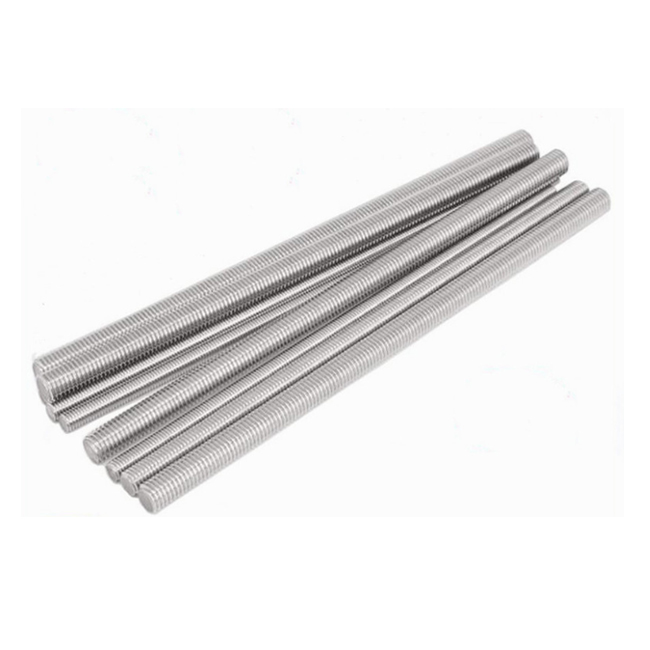
Standard: DIN975,DIN976
GRADE: A2-70,A4-80
Material: stainless steel A2-304,A4-316,SMO254,201,202,
Size:from #6 to 2”, from M3 to M64.
Length:from 36",72",144" ,from 1000 mm,2000 mm,3000 mm
Surface finish:Plain or Customized
Packing: cartons with furmigated pallets
Supply ability: 50tons per month
Assembly: normally with nut or hex flange nut
Stainless steel thread rods, or SS threaded rods, are a versatile and essential component in various construction and manufacturing projects. These rods are commonly used to secure and hold together two or more objects and can withstand high levels of tension and pressure. In this article, we will provide you with a comprehensive guide on SS threaded rods, covering their material selection, applications, and best practices.
1. Introduction
Stainless steel threaded rods are used in a variety of applications, ranging from construction to manufacturing. These rods are known for their high tensile strength, corrosion resistance, and durability. They come in different sizes, lengths, and materials to suit different applications.
In this article, we will delve deeper into SS threaded rods, discussing their characteristics, material selection, applications, and best practices.
2. What are SS Thread Rods?
SS threaded rods are long, cylindrical rods with threads on both ends. These threads enable the rods to be screwed into a tapped hole, securing two or more objects together. They are made of stainless steel, a material known for its excellent mechanical and chemical properties.
SS threaded rods come in various grades, such as 304 and 316, depending on their intended use. These grades offer different levels of corrosion resistance, tensile strength, and durability.
3. Material Selection for SS Thread Rods
When selecting an SS threaded rod, several factors must be considered, including the environment in which the rod will be used, the type of load it will be subjected to, and the intended lifespan of the rod.
Stainless steel threaded rods are available in different grades, including 304, 316, and 18-8. These grades offer varying levels of corrosion resistance, tensile strength, and durability.
For applications that require high levels of corrosion resistance, such as marine environments, 316-grade SS threaded rods are recommended. 304-grade SS threaded rods are suitable for most applications and are more cost-effective than 316-grade.
4. Applications of SS Thread Rods
SS threaded rods are used in a variety of applications, including:
4.1. Construction
In the construction industry, SS threaded rods are used to anchor structural elements such as beams, columns, and walls. They are also used to secure concrete formwork and hold down equipment.
4.2. Manufacturing
In the manufacturing industry, SS threaded rods are used to hold together different components of machinery and equipment. They are also used to secure bolts, nuts, and other fasteners.
4.3. Electrical
In the electrical industry, SS threaded rods are used to secure electrical components such as transformers, switchgear, and busbar systems.
4.4. Plumbing
In the plumbing industry, SS threaded rods are used to anchor pipes, fixtures, and supports.
5. Best Practices for SS Thread Rods
When working with SS threaded rods, it is essential to follow best practices to ensure their optimal performance and longevity. Some best practices include:
5.1. Proper Installation
SS threaded rods must be installed correctly to prevent damage or failure. It is crucial to use the appropriate torque and thread engagement to ensure that the rod is securely fastened.
5.2. Regular Inspection
SS threaded rods should be inspected regularly to detect any signs of damage or corrosion. Regular inspection ensures that the rods are functioning correctly and can prevent failures.
5.3. Use of Appropriate Coatings
Applying appropriate coatings to SS threaded rods can increase their corrosion resistance and lifespan. Common coatings used include zinc, hot-dip galvanizing, and epoxy.
5.4. Avoiding Overloading
SS threaded rods should not be subjected to loads beyond their capacity. Overloading can cause the rods to deform or fail, leading to potential safety hazards.
5.5. Proper Storage
SS threaded rods should be stored in a dry and clean environment to prevent corrosion and damage. They should also be stored away from moisture and chemicals that can cause degradation.
6. Conclusion
Stainless steel threaded rods are a versatile and essential component in various construction and manufacturing projects. Selecting the appropriate grade, proper installation, regular inspection, and use of appropriate coatings are some of the best practices that ensure their optimal performance and longevity.
By following these best practices, you can ensure that your SS threaded rods perform their intended function and last for a long time.
7. FAQs
What is the difference between 304 and 316-grade SS threaded rods?
304-grade SS threaded rods are more cost-effective and suitable for most applications. However, for applications that require high levels of corrosion resistance, such as marine environments, 316-grade SS threaded rods are recommended.
How are SS threaded rods installed?
SS threaded rods are installed by screwing them into a tapped hole using an appropriate torque and thread engagement.
What are some common coatings used for SS threaded rods?
Common coatings used for SS threaded rods include zinc, hot-dip galvanizing, and epoxy.
Can SS threaded rods be overloaded?
No, SS threaded rods should not be subjected to loads beyond their capacity. Overloading can cause the rods to deform or fail, leading to potential safety hazards.
How should SS threaded rods be stored?
SS threaded rods should be stored in a dry and clean environment away from moisture and chemicals that can cause degradation.

